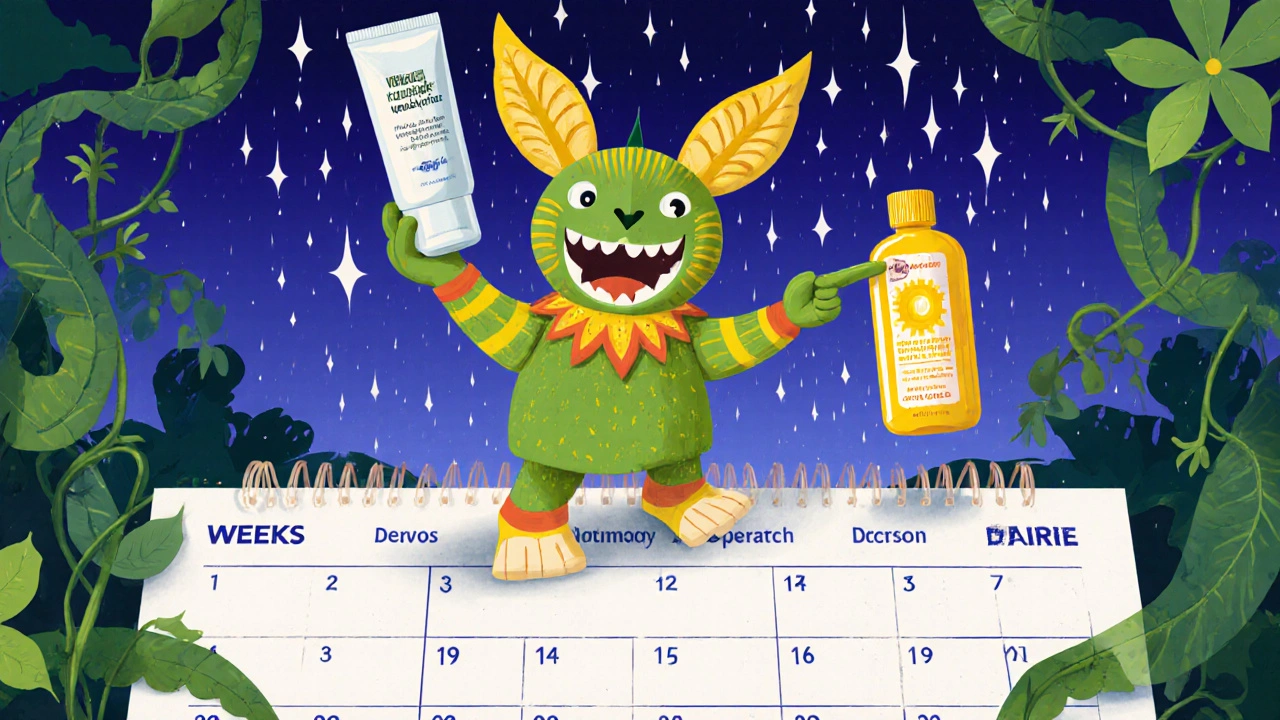Tazarotene Usage Calculator
Personalize Your Tazarotene Routine
Based on the article, we'll help you determine the ideal starting frequency for tazarotene based on your skin type and condition.
Your Personalized Recommendation
Expected Adjustment Timeline
Key Tip: Start slowly. As the article states, "Don't expect overnight miracles. The skin may flake a bit, but that's the shedding process."
Important Note: If you experience excessive redness or peeling, reduce frequency. As noted in the article: "If your skin becomes too flaky, scale back to every-other-night use."
Tazarotene is a prescription‑only topical retinoid approved for treating acne vulgaris and plaque psoriasis. It works by normalising skin cell turnover, preventing clogged pores, and reducing inflammation. People who struggle with stubborn breakouts often wonder whether it really delivers the promised clearer skin. Below are real‑life accounts, practical tips, and the science that explains why tazarotene can be a game‑changer.
How Tazarotene Works at the Cellular Level
When applied, tazarotene binds to retinoic acid receptors (RAR‑β and RAR‑γ) inside keratinocytes. This triggers a cascade that speeds up the shedding of dead skin cells and curbs the production of excess sebum. The result is fewer comedones, less redness, and a smoother epidermis. Unlike over‑the‑counter retinol, tazarotene is a third‑generation retinoid, meaning its molecular structure is more stable and it penetrates the dermis more efficiently.
Who Should Consider Tazarotene?
- Moderate to severe inflammatory acne that hasn’t responded to benzoyl peroxide or salicylic acid.
- Patients with post‑inflammatory hyperpigmentation (PIH) looking for a dual‑action solution.
- Adults and teenagers (12+) with clear medical clearance.
Contra‑indications include pregnancy, breastfeeding, and a history of severe eczema. A dermatologist should always evaluate skin type and any concurrent medications before starting.
Real‑Life Success Stories
Below are five anonymised accounts collected from forums, clinic follow‑ups, and patient surveys. Names and locations have been changed for privacy.
1. Emma, 24 - From Persistent Cysts to Smooth Matte Finish
Emma struggled with cystic acne on her jawline for three years. She tried over‑the‑counter benzoyl peroxide gels at 2.5% and a routine of salicylic acid cleansers, but new lesions kept popping up. After a dermatologist prescribed 0.1% tazarotene cream, she followed a gentle protocol: apply a pea‑sized amount every other night, moisturise with a ceramide‑rich cream, and wear SPF 30 daily.
Within four weeks, she reported a 60% reduction in inflamed lesions. By week eight, the cysts were gone, and the skin’s texture felt softer. Emma’s biggest tip: “Don’t expect overnight miracles. The skin may flake a bit, but that’s the shedding process. Keep using a non‑comedogenic moisturizer and the results will follow.”
2. Marco, 31 - Tackling Post‑Inflammatory Hyperpigmentation
Marco’s acne left dark brown spots on his cheeks after each breakout healed. He tried hydroquinone creams, but the spots remained stubborn. His dermatologist added a low‑dose tazarotene 0.05% gel to his regimen, paired with a vitamin C serum in the morning.
After three months, Marco’s PIH faded by roughly 40%. He attributes the improvement to tazarotene’s ability to accelerate epidermal turnover, effectively “scrubbing” the pigmented cells away. He also stresses the importance of sunscreen: “I use a mineral SPF 50 every day; otherwise the spots would have darkened again.”
3. Aisha, 19 - Managing Acne on Sensitive Skin
Aisha has sensitive, rosacea‑prone skin that reacts easily to harsh ingredients. Her dermatologist started her on a 0.025% tazarotene cream applied every third night, combined with a gentle hyaluronic acid moisturizer.
After six weeks, her inflammatory papules decreased, and there was no noticeable redness flare‑up. She learned to “listen to your skin”; on days when she felt a tingling sensation, she delayed the next application by 24‑48 hours. This flexibility helped her stay consistent without irritation.
4. Liam, 42 - Using Tazarotene After Oral Isotretinoin
Liam completed a course of oral isotretinoin two years ago but still had occasional stubborn comedones on his back. His doctor suggested a maintenance phase with 0.1% tazarotene cream on affected areas twice a week.
Six months later, Liam reports a drastic drop in new breakouts and a smoother back. He notes that because isotretinoin already reduced sebaceous gland activity, tazarotene’s cell‑turnover boost was enough to keep his skin clear.
5. Sofia, 27 - Combining Tazarotene with Other Topicals
Sofia loves a layered approach. She combines 0.1% tazarotene at night with a morning routine of a niacinamide serum and a lightweight zinc oxide sunscreen. She also uses a spot‑treatment of 2% benzoyl peroxide on active lesions, but only after the tazarotene has settled for 30 minutes.
After five months, her acne count is down to the single digits, and her skin feels more even. Her advice: “Don’t over‑load your skin. One active retinoid at night is enough; keep the rest of the routine simple and supportive.”

Tips for Getting the Best Results
- Start Slow: Begin with every‑other‑night applications. Increase frequency as tolerance builds.
- Moisturise First: Apply a neutral, fragrance‑free moisturizer 10‑15 minutes before tazarotene to reduce irritation.
- Sun Protection Is Non‑Negotiable: Use a broad‑spectrum SPF 30 or higher every morning. UV exposure can worsen hyperpigmentation and counteract retinoid benefits.
- Avoid Harsh Exfoliants: Suspend physical scrubs and chemical exfoliants (AHAs/BHAs) for at least two weeks after starting tazarotene.
- Watch for Pregnancy: Tazarotene is classified as Pregnancy Category C. If you become pregnant or plan to, stop use immediately and consult your doctor.
Common Pitfalls and How to Fix Them
- Excessive Redness or Peeling: Reduce application frequency; add a barrier‑repair cream containing ceramides and niacinamide.
- Breakouts Still Occurring: Ensure you’re not over‑cleansing. A mild, pH‑balanced cleanser is sufficient. Also, evaluate diet and stress levels.
- Hyperpigmentation Worsening: Double‑down on sunscreen and consider adding a gentle vitamin C serum in the morning to inhibit melanin production.

How Tazarotene Stacks Up Against Other Topical Retinoids
| Retinoid | Typical Strength | Primary Indication | Onset of Visible Improvement | Typical Side‑Effect Profile |
|---|---|---|---|---|
| Tazarotene | 0.025%‑0.1% | Acne vulgaris, plaque psoriasis | 4‑8 weeks | Initial dryness, mild erythema; improves with moisturiser |
| Adapalene | 0.1%‑0.3% | Mild‑moderate acne | 6‑12 weeks | Less irritation than tazarotene; occasional burning |
| Retinol (OTC) | 0.01%‑0.5% | Anti‑aging, mild acne | 12‑16 weeks | Variable; may cause redness if concentration too high |
For patients who need a stronger, faster‑acting solution, tazarotene often outperforms adapalene and retinol, especially when acne is moderate to severe. However, its higher potency means a more cautious start is essential.
Mini‑FAQ: Your Most Common Questions Answered
Can I use tazarotene if I have oily skin?
Yes. Tazarotene actually helps regulate sebum production, making it suitable for oily skin. Just pair it with a lightweight, oil‑free moisturizer to keep the barrier intact.
How long does it take to see clearer skin?
Most users notice a reduction in fresh breakouts within 4‑6 weeks, but full results-especially on hyperpigmentation-can take 3‑6 months of consistent use.
Is it safe to combine tazarotene with benzoyl peroxide?
Yes, but apply them at different times of day. Use benzoyl peroxide in the morning after cleansing, and tazarotene at night. This separation reduces the risk of excessive irritation.
What should I do if my skin becomes too flaky?
Scale back to every‑other‑night use and add a richer, barrier‑repair cream containing ceramides, cholesterol, and fatty acids. Avoid physical scrubs; let the retinoid do the exfoliation.
Can I stay on tazarotene indefinitely?
Many dermatologists recommend long‑term maintenance at a lower frequency (e.g., twice a week) once clear skin is achieved. Continuous, low‑dose use helps prevent relapse without overwhelming the skin.
Bottom Line: Is Tazarotene Worth Trying?
If you’ve cycled through benzoyl peroxide, salicylic acid, and over‑the‑counter retinoids with limited success, the real‑life stories above show that tazarotene can deliver noticeable, lasting clearance-provided you follow a gentle, consistent routine and protect your skin from the sun. Talk to a qualified Dermatologist to see if this prescription retinoid fits your specific needs.

Natalie Morgan
October 20, 2025 AT 16:37Start slow with tazarotene, keep it every other night and add a fragrance‑free moisturizer.
Mahesh Upadhyay
October 25, 2025 AT 07:43Too many people jump on the hype; the irritation alone proves it’s not a miracle cure.
Rajesh Myadam
October 29, 2025 AT 21:50It’s impressive how a consistent routine can gradually calm inflammation, especially when paired with a gentle cleanser and consistent sunscreen use.
Andrew Hernandez
November 3, 2025 AT 12:57In many regions the availability of tazarotene is limited so consulting a dermatologist is essential to get a proper prescription.
Alex Pegg
November 8, 2025 AT 04:03The pharma push for stronger retinoids often overlooks the potential for over‑prescription and long‑term skin barrier damage.
laura wood
November 12, 2025 AT 19:10People with sensitive skin can still benefit if they buffer the retinoid with a ceramide‑rich cream and monitor for any tingling sensations.
Kate McKay
November 17, 2025 AT 10:17Tazarotene can feel intimidating at first, but you’re not alone in this journey.
The key is to treat it like a marathon, not a sprint.
Begin with a pea‑size amount every other night.
Observe how your skin reacts for a few days before increasing frequency.
Pair it with a lightweight, non‑comedogenic moisturizer to keep the barrier happy.
Consistent SPF is non‑negotiable because retinoids can make your skin more photosensitive.
If you notice excessive peeling, cut back to twice a week and focus on hydration.
Many users report that after the initial purge, the skin tone becomes noticeably smoother.
Combining a vitamin C serum in the morning can boost brightening results while protecting against free radicals.
Remember that diet, stress, and sleep all play supporting roles in acne management.
Keep a simple routine; stacking too many actives often leads to irritation.
If you have hormonal fluctuations, consider discussing adjunct therapies with your dermatologist.
Track your progress with photos every two weeks to stay motivated.
Celebrate small victories, like a reduction in new lesions or less redness.
Patience truly pays off – most people see significant improvement within three to six months.
Stay consistent, stay protected, and trust the process.
Demetri Huyler
November 22, 2025 AT 01:23While tazarotene is effective, the truly discerning skin‑care aficionado will seek out compounded formulations that include peptides and antioxidants for added prestige.
JessicaAnn Sutton
November 26, 2025 AT 16:30Clinical data indicate that the statistically significant reduction in inflammatory lesions appears after four weeks, yet patient adherence often drops when early side‑effects emerge.
Israel Emory
December 1, 2025 AT 07:37Indeed, the hype surrounding potent retinoids can be overwhelming, especially when promotional material exaggerates outcomes, and this may lead some users to expect instant perfection, which is rarely realistic, so a measured approach remains advisable.
Sebastian Green
December 5, 2025 AT 22:43Consistency is everything.
Wesley Humble
December 10, 2025 AT 13:50From a dermatological standpoint, the pharmacokinetic profile of tazarotene supports its superior efficacy relative to older retinoids; however, patient education on barrier repair is paramount. 📚💊
barnabas jacob
December 15, 2025 AT 04:57Yo, the endo‑exfoliation thing is legit but if u skip moisturizer you’ll be rockin’ the desert skin vibe.
jessie cole
December 19, 2025 AT 20:03Fear not, dear reader, for the path to clear skin is paved with perseverance, patience, and the occasional heroic moisturizer.
Kirsten Youtsey
December 24, 2025 AT 11:10One must wonder whether the rapid market push of tazarotene is less about patient care and more about a covert agenda to monopolize the retinoid sector.